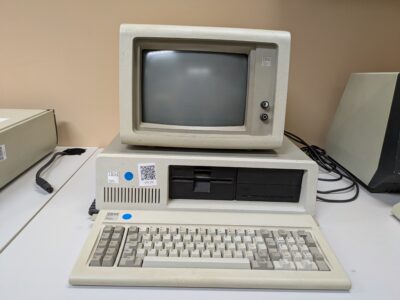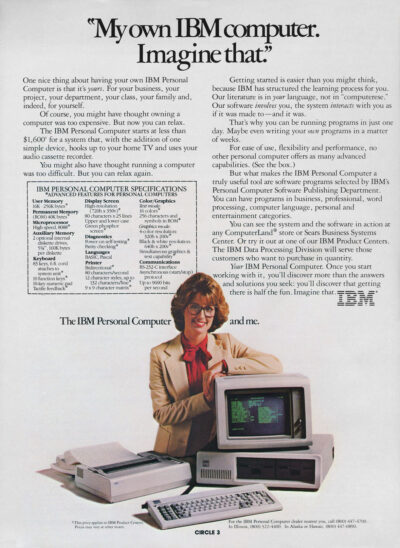IBM PC 5150 (Original PC)
The IBM PC 5150, the original PC, was introduced on August 12, 1981 it was IBM’s first microcomputer and set the standard for personal computing with its open architecture, use of off-the-shelf components, and compatibility with third-party hardware and software. Its most notable features included an Intel 8088 processor running at 4.77 MHz, five ISA expansion slots, and support for both monochrome and color graphics, making it highly expandable and adaptable for business and home use. The 5150’s claim to fame was its role in launching the “PC revolution,” establishing the IBM-compatible standard that would dominate the industry for decades, and propelling Microsoft DOS to the forefront as the primary operating system. It was extremely popular, with IBM selling 65,000 units in four months and taking 100,000 orders by Christmas of 1981.
- Manufacturer: International Business Machines (IBM)
- Type: Desktop Personal Computer (PC)
- Release Date: August 1981
- Cost at release: USD $1,565 (CAD ~$6,100 adjusted for inflation)
- Cost with peripherals: USD $6,000 (CAD ~$23,500 adjusted for inflation)
- MIPS: 0.33 (330 KIPS)
Hardware Specifications
- CPU: Intel 8088 @ 4.77 MHz (16-bit internal, 8-bit external bus)
- Memory: 16 KB (base) to 256 KB on motherboard; expandable to 640 KB with add-on cards
- Expansion: 5 ISA (Industry Standard Architecture) slots
- Storage: One or two 5.25″ floppy drives (160 KB or 320 KB each); cassette tape interface (rarely used)
- Graphics: Choice of Monochrome Display Adapter (MDA) or Color Graphics Adapter (CGA), MDA: 80×25 text only, CGA: Up to 320×200 in 4 colors, or 640×200 in monochrome
- Sound: Simple internal speaker (single programmable-frequency square wave)
- Keyboard: 83-key Model F keyboard
- Ports: Parallel, serial, cassette, expansion slots
- Power Supply: 63.5W internal
- Physical: 24–30 lb (11–14 kg); two full-height drive bays
Operating System & Programming Languages
-
Operating System: IBM PC DOS (developed by Microsoft, later known as MS-DOS), but also supported CP/M-86 and the UCSD p-System
-
Supported Languages: Languages available included IBM BASIC (in ROM and disk versions), Microsoft BASIC, Pascal, FORTRAN, COBOL, and C, among others
Notables
- IBM’s first microcomputer and set the standard for personal computing with its open architecture and published technical specifications enabled a booming market for third-party hardware and software, spawning the entire IBM-compatible PC industry.
- The IBM PC was developed in just one year, an incredibly short time for IBM which was known for taking years to create new products.
- It was unveiled on August 12, 1981, at the Waldorf Hotel in New York.
- The project to create the PC was codenamed “Project Chess”.
- The system’s massive popularity and influence led to the term “PC” becoming synonymous with personal computers in general, and its architecture remains foundational for modern PCs.
- IBM’s advertising campaign featured Charlie Chaplin’s “Little Tramp” character, making the PC a cultural icon.
- The 5150 was not the first personal computer, but it was the first to achieve mainstream business and consumer adoption, outpacing competitors like Apple, Commodore, and Atari.
- The original IBM PC keyboard is still renowned for its tactile quality and durability.
- The model number “5150” has no special meaning beyond IBM’s internal numbering scheme.
- Many IBM PCs remained in use for decades, including in specialized roles such as weather data processing by the U.S. National Weather Service.
- It created the standards that dominated personal computing for the next 40 years
- The open architecture led to a booming market of IBM PC-compatible computers
- “Colossal Cave Adventure” was the first video game available for the IBM PC
- Some original IBM PCs from 1981 still function today, over 40 years later, due to their modular design and high-quality manufacturing
Video
Donated by: Arlen Michael

